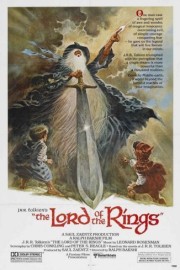The Lord of the Rings
What it must have been like, to watch Ralph Bakshi’s 1978 adaptation of J.R.R. Tolkien’s fantasy masterpiece in the years before Peter Jackson’s seemingly-definitive trilogy. I can only imagine the frustration, and excitement, fans of Middle Earth felt at the time, when Bakshi’s movie was the only cinematic attempt to bring Tolkien’s world to life. Alas, it was only the first half of “Rings”…well, unless you consider the Rankin-Bass cartoons of “Return of the King” and “The Hobbit.” (And for purposes of my sanity, let’s not, shall we?)
Animation seems like an ideal method of bringing the detail, and having an iconoclastic talent like Bakshi (who had previously scored a hit with his X-rated adaptation of “Fritz the Cat”) at the helm was a good move on the part of Saul Zaentz, the producer who held the film rights to Tolkien’s books for many years. Bakshi had been inspired by Tolkien’s universe himself, after a friend had introduced him to the stories, so as with Jackson, we had a filmmaker who was genuinely passionate about the material.
So why doesn’t this film work better? Watching it for only the second time in 10 years, it remains obvious that trying to tell the story in a condensed version doesn’t work. I’m much more impressed by the animation– a combination of cel animation and rotoscoping –than I was before, but this is like a greatest hits album of Tolkien’s story: it hits all the high points, but lacks the context that gives those hits depth and feeling. That makes seeing this film’s successes (namely in its visual chances) all the more painful.
The most egregious failure of this film is in its characterization of Samwise Gamgee, Frodo’s fiercest ally. In Bakshi’s film, he comes off less as a potential hero, and more as a buffoon, even more so than Merry and Pippen. It’s impossible to take him seriously as a companion that will benefit Frodo on his journey. I don’t know if the screenplay (by Chris Conkling and Peter S. Beagle) is more to blame, or the voice performance (by Michael Scholes), or a combination of the two, but I really forgot how bad the character was overall in the way he is portrayed in this film, especially compared to Sean Astin’s performance in the Jackson films.
If “Lord of the Rings” was to be brought to the big screen in animation, I’m glad that it came not from a studio like Disney, but is the work of an individual. The style that brought us “Snow White and the Seven Dwarfs,” “Dumbo,” and “Cinderella” would have been all wrong for Tolkien’s universe. Similarly, a foreign studio like Miyazaki’s Studio Ghibli wouldn’t have hit the right visual notes, either. True, the combination of cels and rotoscoping (where live-action elements are painted over) is difficult to get used to when watching the film the first time, but seeing it a second time, I love the rough, surreal quality the elements have. This is absolutely the correct visual look for Bakshi’s Middle Earth, and makes one even more curious to delve deeper into the filmmaker’s work (especially “Wizards,” which, I’m thinking, will be a “Movie a Week” choice in 2013) in the future.
I haven’t really discussed the story because, at this point, I’m guessing most people know it already by way of Jackson’s films. I will say that there are beats in the story, especially in the way Merry and Pippen escape the orcs, that are included here, but missed the cut in Jackson’s films. That said, Jackson’s movies still get the story right more often than not, although only a fool would dismiss Bakshi’s attempt at the film outright. It’s far too compelling a visual experience, even if it fails pretty miserably as a narrative one.










